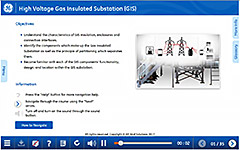Gas-Insulated Substation Suite of 3 modules (ELSHVGIS)
What will I learn from this course?
Understand the role of HV Gas-Insulated Substation, and gain insight on components and transformers.
Topics
High Voltage Substation Module
- Role and function of a HV Substation
- Voltage levels associated with each network (LV, MV, HV, EHV, UHV)
- Network disturbances/distinguishing Internal & external insulation failures
- What factors determine the cost and architectural layout
- AIS vs. GIS
- Components found within an HV Substation
- SF6 Gas (general overview)
- Innovative solutions for both AIS and GIS
Gas-Insulated Substation Module
- Definition
- Enclosure & insulation materials
- Induced current
- Partitioning
- Connection interfaces: HV cables, overhead lines, transformer
- Rated characteristics (GE Vernova range)
- GIS circuit breaker: interrupting chamber breaking sequence, technological advancements, control & monitoring
- GIS disconnector
- GIS earthing switch including information on combined technology
- Surge arresters
- Instrument transformers: current & voltage transformers
- Busbars (GIL)
Power Transformer Module
- Definition and Operating Principle: Transformation Ratio
- Components (Active Part, Winding Layouts, Insulation, Bushings, Conservator, Cooling System, broad overview Load vs. No Load Losses)
- Why and which Tap Changer is needed?
- Protection Devices (Lightning Arrester, Buchholz Relay, Pressure Relief Device)
- History of Power Transformers
- Power Transformer Applications: Generator Transformer, Auto-Transformers, Shunt Reactor, HVDC Convertor Transformer, Smoothing Reactor, Furnace Transformer, Interconnection Transformer, Step-Down Transformer, Rectifier Transformer, Trackside Transformer
- Transformer definition and specification: Insulation Levels, Impedance, Temperature Rise, Loss Capitalization, Transportation
- Maintenance Fundamentals
Languages
This suite of online courses is available in English.
| Duration | Who should attend? |
|---|---|
| 2H 15 mns | Personnel working in an electrical environment |
Gas-Insulated Substation Suite of 3 modules (ELSHVGIS)
What will I learn from this course?
Understand the role of HV Gas-Insulated Substation, and gain insight on components and transformers.
Topics
High Voltage Substation Module
- Role and function of a HV Substation
- Voltage levels associated with each network (LV, MV, HV, EHV, UHV)
- Network disturbances/distinguishing Internal & external insulation failures
- What factors determine the cost and architectural layout
- AIS vs. GIS
- Components found within an HV Substation
- SF6 Gas (general overview)
- Innovative solutions for both AIS and GIS
Gas-Insulated Substation Module
- Definition
- Enclosure & insulation materials
- Induced current
- Partitioning
- Connection interfaces: HV cables, overhead lines, transformer
- Rated characteristics (GE Vernova range)
- GIS circuit breaker: interrupting chamber breaking sequence, technological advancements, control & monitoring
- GIS disconnector
- GIS earthing switch including information on combined technology
- Surge arresters
- Instrument transformers: current & voltage transformers
- Busbars (GIL)
Power Transformer Module
- Definition and Operating Principle: Transformation Ratio
- Components (Active Part, Winding Layouts, Insulation, Bushings, Conservator, Cooling System, broad overview Load vs. No Load Losses)
- Why and which Tap Changer is needed?
- Protection Devices (Lightning Arrester, Buchholz Relay, Pressure Relief Device)
- History of Power Transformers
- Power Transformer Applications: Generator Transformer, Auto-Transformers, Shunt Reactor, HVDC Convertor Transformer, Smoothing Reactor, Furnace Transformer, Interconnection Transformer, Step-Down Transformer, Rectifier Transformer, Trackside Transformer
- Transformer definition and specification: Insulation Levels, Impedance, Temperature Rise, Loss Capitalization, Transportation
- Maintenance Fundamentals
Languages
This suite of online courses is available in English.
| Duration | Who should attend? |
|---|---|
| 2H 15 mns | Personnel working in an electrical environment |
